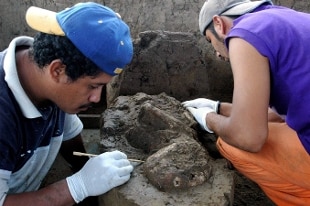Share
25 August 2019A funerary ritual typical of ancient Mediterranean cultures, but unknown in pre-Columbian American civilizations, was discovered in the necropolis of Comalcalco, a Mayan city on the coast of the Gulf of Mexico: burial of bodies in jars (whose symbolism could mean returning to the womb) of the mother earth inside the uterus, represented by the container vessel) numerous have been brought to light in the cemetery complex of the city and, together with other strong clues emerged in recent excavations, authorize the hypothesis (to be verified) of the settlement of a community of navigators from the Mediterranean.
The waiting for the outcome of the excavations, still in progress, is alive. "The recent discovery of the necropolis of Comalcalco - explains the Italian American archaeologist Maria Longhena - has yielded numerous burials in the jar: this type of funerary ritual, much in use in ancient cultures of the Mediterranean, does not find corresponding in American contexts".
The city of Comalcalco, in the current Mexican state of Tabasco, flourished in the classical Mayan period (around 250-980 AD), but its foundation, reveals Longhena, "has its roots already in the pre-classical period. The site has characteristics unique and detached from the Mayan and in any case Amerindian cultural context, which has been the subject of discussion among scholars for many decades, in particular the use of baked clay bricks for the construction of the pyramids, and the system of water pipes always in baked clay: both elements represent a unicum in the New Continent ", but they are common architectural elements in the ancient Mediterranean.
According to the American archaeologist, this is "further evidence of very ancient contacts between the American continent and the old world", which, together with others still under study, enrich the line of research launched ten years ago by Elio Cadelo, with his "scandalous" innovative text "When the Romans went to America", which sums up a very nutritious series of classical archaeological and literary clues to demonstrate the ancient commercial frequentation of the trans-Atlantic routes. The latest discoveries and related discussions are now gathered in the new book of Cadelo "the Ocean of the Ancients".

